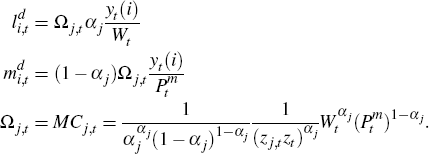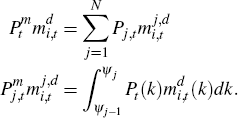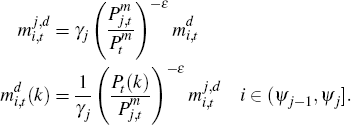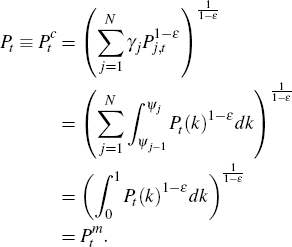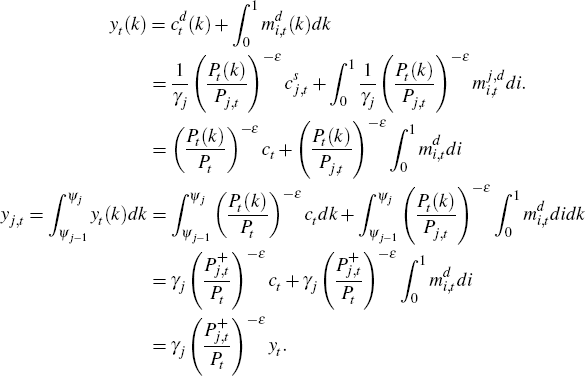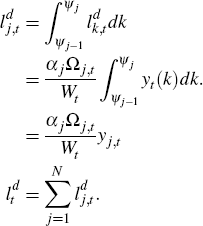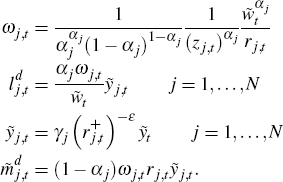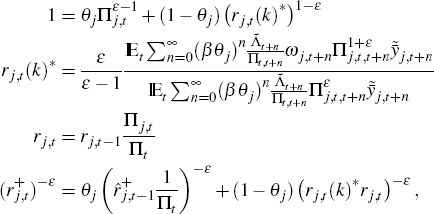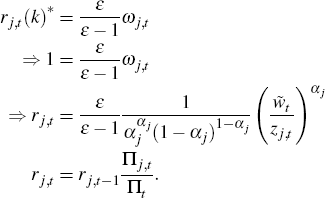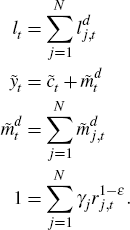RDP 2010-01: Reconciling Microeconomic and Macroeconomic Estimates of Price Stickiness Appendix A: The Model
March 2010
- Download the Paper 462KB
The economy consists of a unit interval of identical households, N final-goods producers, a continuum of intermediate-goods producers and a monetary authority.
There is a continuum of intermediate-goods producers, indexed on the unit interval (0, 1]. Each sector of the economy is represented by a sub-interval (Ψj−1, Ψj], where 0 = Ψ0 <Ψ1 < ... < ΨN = 1. The sub-intervals are not necessarily of the same length, so the measure of sector j is given by γj = Ψj – Ψj−1. A final-goods producer in sector j only uses intermediate goods produced by intermediate-goods firms belonging to the sub-interval (Ψj−1, Ψj].
A.1 Households
Given initial holdings of bonds, B−1, and money, H−1, the
sequence of wages, prices for final consumption goods, prices for the aggregate
consumption good and nominal interest rates  and the sequence of
monetary transfers and dividends
and the sequence of
monetary transfers and dividends  , the sequence of aggregate consumption, consumption
of final consumption goods, money holdings, labour supply and bond holdings,
, the sequence of aggregate consumption, consumption
of final consumption goods, money holdings, labour supply and bond holdings,
 solves the following intertemporal maximisation problem
solves the following intertemporal maximisation problem
subject to
Using the Lagrange multiplier Λt on the budget constraint, we get the following first-order conditions
We also have
We assume the preference process evolves as follows
A.2 Final-goods Firms
There are N sectors, indexed by j. Final-goods firms are perfectly competitive and make zero profits in equilibrium. They sell final goods to households that are produced using inputs from intermediate producers from their sector.
In period t, final-goods firms take as given their total production,  and prices for their
output and intermediate-goods prices,
and prices for their
output and intermediate-goods prices,  , and solve the following
cost-minimisation problem
, and solve the following
cost-minimisation problem
subject to
There is also a zero-profit condition that must also be satisfied
The first-order conditions become
where
A.3 Intermediate-goods Firms
Intermediate-goods firms are monopolistically competitive. Intermediate-goods producers
in sector j can only change their prices in any given period with Calvo probability
θj. Once prices have been determined, intermediate-goods
firms produce to meet demand for their good from final-goods producers and
other intermediate-goods producers. Demand for labour and other intermediate
goods are determined by cost minimisation. Firm i in sector j
takes wages, Wt , and the price for the aggregate intermediate
good,  ,
as given to solve the following cost-minimisation problem
,
as given to solve the following cost-minimisation problem
subject to:
where: zj,t is sector-specific productivity; zt
is the state of aggregate productivity;  is labour demanded
by firm i; and
is labour demanded
by firm i; and  is firm i's demand for the aggregate
intermediate good. The production constraint is binding and the Lagrange multiplier
on the production constraint, Ωj,t , is the nominal
marginal cost and is sector specific. First-order conditions are:
is firm i's demand for the aggregate
intermediate good. The production constraint is binding and the Lagrange multiplier
on the production constraint, Ωj,t , is the nominal
marginal cost and is sector specific. First-order conditions are:
We define:
where  is the demand for output from sector j by firm k, which can be
expressed as follows:
is the demand for output from sector j by firm k, which can be
expressed as follows:
So firms decide how to allocate their expenditure on intermediate goods across sectors, then decide within a sector from which firms it will source its intermediate inputs, given intermediate-goods prices, {Pt(i)}i∈(0,1], so that
From cost minimisaton, we find that:
Using these results, we can derive the following expressions for the aggregate price index, the sectoral price indices and an expression for a firm's demand for intermediate inputs
When firms are able to reset their prices, they solve the following problem:
First-order conditions give us:
Dividends distributed to households are just period t profits:
and
In equilibrium, total dividends to households will equal nominal value added less
total nominal payments to labour ( ).
).
We assume that the aggregate technology and sectoral technology processes evolve as follows
where: μz is the average growth rate of aggregate technology; εz,t is the shock to aggregate technology, and εz,j,t is the sector-specific technology shock.
A.4 Monetary Authority
The monetary authority follows the following policy rule:
where  and
and  .
.
Define the gross rate of growth of the money supply to be  .
Given its target for the nominal interest rate, nominal transfers Tt
is given by (
.
Given its target for the nominal interest rate, nominal transfers Tt
is given by ( − 1)Ht−1
and
− 1)Ht−1
and  is determined endogenously by the money demand equation and money market clearing:
is determined endogenously by the money demand equation and money market clearing:
A.5 Market-clearing Conditions
There are N markets for N final goods, a unit interval of markets for intermediate goods, a labour market, a bond market and a money market.
A.5.1 Price indices
We define two price indices. The first, Pt should be familiar to the reader. The second,  , is introduced for
convenience.
, is introduced for
convenience.
A.5.2 Intermediate goods market-clearing
Using the final goods market-clearing condition:
where:
Since we can use the first-order conditions of the intermediate-goods firm k belonging to sector j to get:
We can also express sectoral output as follows:
where:
So:
A.5.3 Labour market-clearing
Labour demand by each firm is given by
Aggregating this across sector j:
A.5.4 Sectoral price indices
In any given period, a firm in sector j has probability (1 – θj) that it can change its price. This implies that the price index for sector j evolves as follows:
Similarly, for the alternative price index:
A.6 Transformations and Normalisations
Due to the growth in aggregate technology, we detrend some variables to make them stationary so
We also define:
A.7 Summary of Non-linear Equations
This sub-section summarises the first-order conditions and market-clearing conditions required to solve the model at the sectoral level (rather than at the firm level). For completeness, and the interest of the reader, we present equations for sectors subject to the Calvo mechanism and those with flexible pricing, even though the latter are not used.
For k ∈ (Ψj−1, Ψj] and j = 1,...,N:
Sticky price sector indices follow
where  and
and  .
.
Flexible price sector prices:
The market-clearing and aggregation equations become:
Stochastic processes are
A.8 Log-linearised Equations
Using the equations above, we denote the log-deviation from trend for variable x to be  .
.
Note that  .
.
Sectoral variables, market-clearing and aggregation equations
where  and
and  represent the steady-state shares of value added and intermediate input of gross
output.
represent the steady-state shares of value added and intermediate input of gross
output.
Flexible prices are set as a constant mark-up over nominal marginal costs while sticky price inflation evolves according to the New-Keynesian Phillips Curve.
Flexible price sectors:
Sticky price sectors:
Driving variables:
In summary, we have 8N + 11 endogenous variables and equations, which completes the model.



















